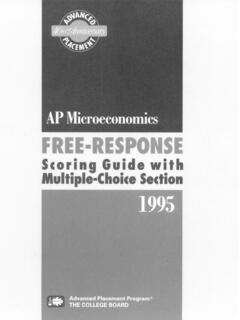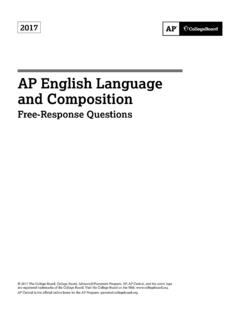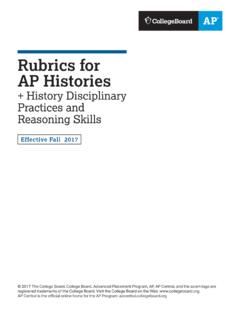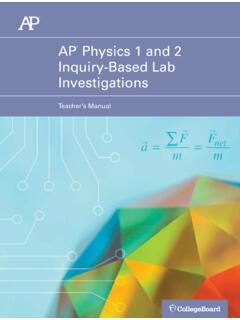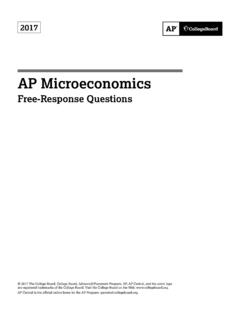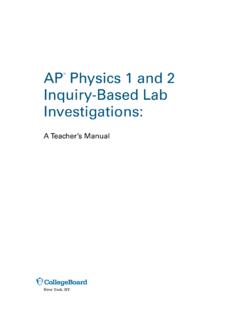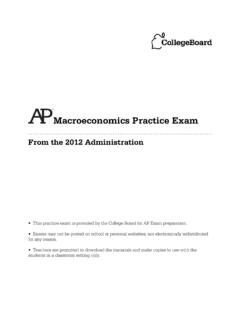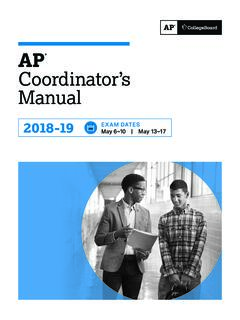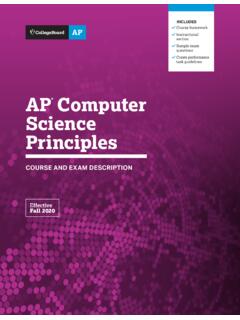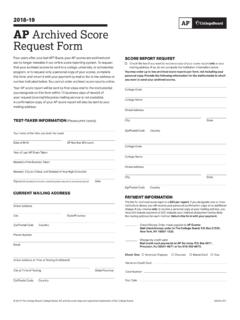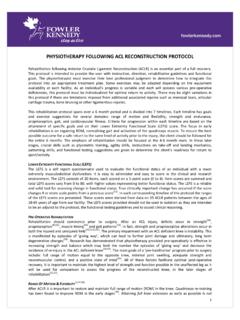Transcription of AP Physics 1: Algebra-Based - AP Central
1 2019. AP Physics 1: . Algebra-Based Free-Response Questions 2019 The College Board. College Board, Advanced Placement, AP, AP Central , and the acorn logo are registered trademarks of the College Board. Visit the College Board on the web: AP Central is the official online home for the AP Program: AP Physics 1 TABLE OF INFORMATION. CONSTANTS AND CONVERSION FACTORS. Proton mass, mp 10 27 kg Electron charge magnitude, e 10 19 C. Neutron mass, mn 10 27 kg Coulomb's law constant, k 1 4 pe0 10 9 N m 2 C2. Universal gravitational Electron mass, me 10 31 kg 10 11 m 3 kg s2. constant, G. Acceleration due to gravity Speed of light, c 108 m s at Earth's surface, g m s2. meter, m kelvin, K watt, W degree Celsius, C. UNIT kilogram, kg hertz, Hz coulomb, C.
2 SYMBOLS second, s newton, N volt, V. ampere, A joule, J ohm, W. PREFIXES VALUES OF TRIGONOMETRIC FUNCTIONS FOR COMMON ANGLES. Factor Prefix Symbol . q 0 30 37 45 53 60 90. 12 tera T. 10. sinq 0 12 35 2 2 45 3 2 1. 10 9 giga G. 10 6 mega M cosq 1 3 2 45 2 2 35 12 0. 10 3 kilo k tanq 0 3 3 34 1 43 3 . 2 centi c 10. 3 milli m 10 The following conventions are used in this exam. 10 6 micro m I. The frame of reference of any problem is assumed to be inertial unless otherwise stated. 9 nano n 10 II. Assume air resistance is negligible unless otherwise stated. 10 12 pico p III. In all situations, positive work is defined as work done on a system. IV. The direction of current is conventional current: the direction in which positive charge would drift.
3 V. Assume all batteries and meters are ideal unless otherwise stated. -2- AP Physics 1 EQUATIONS. MECHANICS ELECTRICITY. x x 0 a x t a = acceleration q1q2 A = area = amplitude FE k = force A r2 F. 1 d = distance I = current x x0 x 0 t ax t 2 Dq 2 E = energy I = length Dt f = frequency P = power x2 x20 2 a x x x0 = force r . F R q = charge I = rotational inertia A R = resistance F Fnet K = kinetic energy DV r = separation a I. m m k = spring constant R t = time L = angular momentum P I DV V = electric potential Ff m Fn = length Rs Ri r = resistivity m = mass i 2 1 1. ac P = power r p = momentum Rp Ri i p mv r = radius or separation T = period Dp F Dt t = time WAVES. U = potential energy f = frequency 1 2 V = volume l v v = speed K mv 2 v = speed f l = wavelength DE W F d Fd cos q W = work done on a system GEOMETRY AND TRIGONOMETRY.
4 X = position DE y = height Rectangle A = area P a = angular acceleration A bh C = circumference Dt m = coefficient of friction V = volume 1 2 Triangle S = surface area q q0 w0t at q = angle 2 1 b = base r = density A bh 2 h = height w w0 at t = torque = length w = angular speed Circle w = width x A cos 2 p ft A pr 2 r = radius DUg mg Dy t t net C 2 pr a I I. 2p 1 Rectangular solid Right triangle T. t rA F rF sin q w f V wh c2 a 2 b2. m a L Iw Ts 2p Cylinder sin q k c DL t Dt V pr 2 . b S 2 pr 2 pr 2 cos q Tp 2p c 1 2 g K Iw a 2 Sphere tan q m1m2 b Fg G 4 3. Fs kx r2 V pr c 3 a 90 . Us 1 2. kx Fg S 4pr 2 q 2 g b m m Gm1m2. r UG . V r -3- 2019 AP Physics 1 FREE-RESPONSE QUESTIONS. Physics 1. Section II. Time 1 hour and 30 minutes 5 Questions Directions: Questions 1, 4, and 5 are short free-response questions that require about 13 minutes each to answer and are worth 7 points each.
5 Questions 2 and 3 are long free-response questions that require about 25 minutes each to answer and are worth 12 points each. Show your work for each part in the space provided after that part. 1. (7 points, suggested time 13 minutes). Identical blocks 1 and 2 are placed on a horizontal surface at points A and E, respectively, as shown. The surface is frictionless except for the region between points C and D, where the surface is rough. Beginning at time t A , block 1 is pushed with a constant horizontal force from point A to point B by a mechanical plunger. Upon reaching point B, block 1 loses contact with the plunger and continues moving to the right along the horizontal surface toward block 2. Block 1 collides with and sticks to block 2 at point E, after which the two-block system continues moving across the surface, eventually passing point F.
6 (a) On the axes below, sketch the speed of the center of mass of the two-block system as a function of time, from time t A until the blocks pass point F at time t F . The times at which block 1 reaches points A. through F are indicated on the time axis. 2019 The College Board. Visit the College Board on the web: GO ON TO THE NEXT PAGE. -4- 2019 AP Physics 1 FREE-RESPONSE QUESTIONS. (b) The plunger is returned to its original position, and both blocks are removed. A uniform solid sphere is placed at point A, as shown. The sphere is pushed by the plunger from point A to point B with a constant horizontal force that is directed toward the sphere's center of mass. The sphere loses contact with the plunger at point B and continues moving across the horizontal surface toward point E.
7 In which interval(s), if any, does the sphere's angular momentum about its center of mass change? Check all that apply. ____ A to B ____ B to C ____ C to D ____ D to E _____ None Briefly explain your reasoning. 2019 The College Board. Visit the College Board on the web: GO ON TO THE NEXT PAGE. -5- 2019 AP Physics 1 FREE-RESPONSE QUESTIONS. 2. (12 points, suggested time 25 minutes). This problem explores how the relative masses of two blocks affect the acceleration of the blocks. Block A, of mass m A , rests on a horizontal tabletop. There is negligible friction between block A and the tabletop. Block B, of mass m B , hangs from a light string that runs over a pulley and attaches to block A, as shown above. The pulley has negligible mass and spins with negligible friction about its axle.
8 The blocks are released from rest. (a). i. Suppose the mass of block A is much greater than the mass of block B. Estimate the magnitude of the acceleration of the blocks after release. Briefly explain your reasoning without deriving or using equations. ii. Now suppose the mass of block A is much less than the mass of block B. Estimate the magnitude of the acceleration of the blocks after release. Briefly explain your reasoning without deriving or using equations. (b) Now suppose neither block's mass is much greater than the other, but that they are not necessarily equal. The dots below represent block A and block B, as indicated by the labels. On each dot, draw and label the forces (not components) exerted on that block after release.
9 Represent each force by a distinct arrow starting on, and pointing away from, the dot. 2019 The College Board. Visit the College Board on the web: GO ON TO THE NEXT PAGE. -6- 2019 AP Physics 1 FREE-RESPONSE QUESTIONS. (c) Derive an equation for the acceleration of the blocks after release in terms of m A , m B , and physical constants, as appropriate. If you need to draw anything other than what you have shown in part (b) to assist in your solution, use the space below. Do NOT add anything to the figure in part (b). (d) Consider the scenario from part (a)(ii), where the mass of block A is much less than the mass of block B. Does your equation for the acceleration of the blocks from part (c) agree with your reasoning in part (a)(ii) ?
10 ____ Yes ____ No Briefly explain your reasoning by addressing why, according to your equation, the acceleration becomes (or approaches) a certain value when m A is much less than m B . (e) While the blocks are accelerating, the tension in the vertical portion of the string is T1. Next, the pulley of negligible mass is replaced with a second pulley whose mass is not negligible. When the blocks are accelerating in this scenario, the tension in the vertical portion of the string is T2. How do the two tensions compare to each other? ____ T2 > T1 ____ T2 = T1 ____ T2 < T1. Briefly explain your reasoning. 2019 The College Board. Visit the College Board on the web: GO ON TO THE NEXT PAGE. -7- 2019 AP Physics 1 FREE-RESPONSE QUESTIONS.
